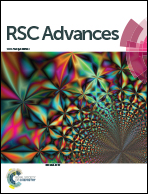Synthesis and characterization of Pd–Ni core–shell nanocatalysts for alkaline glucose electrooxidation†
Abstract
PdshellNicore catalyst decorated carboxylated multi-walled carbon nanotubes (Pd–Ni/C) are synthesized using a two-stage polyol method. The nano-sized Pd–Ni/C catalysts have a metal particle size range of 4.7 to 6.6 nm. The PdshellNicore nanoparticles improve the electrocatalytic activity and durability of glucose oxidation reactions (GORs). X-ray diffraction (XRD), high resolution transmission electron microscopy (HR-TEM), scanning transmission electron microscopy (STEM) and scanning electron microscopy with energy-dispersive X-ray spectroscopy (SEM-EDS) are used to characterize the crystalline structure, particle formation, crystalline nature and elemental distribution, respectively. Cyclic voltammetry (CV), Tafel analysis, chronoamperometry (CA) and multi-cycle cyclic voltammetry (mCV) are used to determine the electrochemical properties of the Pd–Ni/C catalysts. The results indicated that Pd–Ni/C (1 : 0.06) exhibits the highest electrochemical surface area (ECSA) of 78.0 m2 g−1 which is 4.5 times higher than that of Pd/C and as well as having a 1.5-fold higher GOR current density of 21.2 mA cm−2. The stability of Pd–Ni/C toward GOR is also significantly enhanced according to the results of the poisoning rate study and 200 cycling CV test. The highest Pd–Ni/C (1 : 0.06) catalyzed GOR current density of 34.2 mA cm−2 is attained in 0.5 M glucose and 1.0 M NaOH alkaline medium.


 Please wait while we load your content...
Please wait while we load your content...